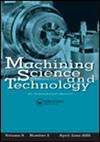Surface morphology on carbon fiber composites by rotary ultrasonic milling
IF 2.6
4区 工程技术
Q2 ENGINEERING, MANUFACTURING
引用次数: 5
Abstract
Abstract Carbon-carbon composites (C/C composites) is typical high temperature resistant material. Therefore it is applied in solid rocket motor (SRM) throat mostly. Because the throat is mostly single piece and mini-batch, which is not suitable for mold forming. Usually, numerical control machining is still the main method. Due to high strength and heterogeneous composites, the machining damage defects are obvious and quality is poor. Thus, from the perspective of C/C composites ablation resistance, rotary ultrasonic machining technology effect on C/C composites surface defects and damage is investigated. Moreover, the influence of ultrasonic vibration on fiber cutting angle and machined surface morphology is analyzed. Meanwhile, based on comparative experiment, fiber pull-out length and surface porosity are presented as characterization parameters. The results show that ultrasonic vibration not only improves fiber cutting angle effectively, but also reduces pores and cracks on machined surfaces. Moreover, it reduces fiber pull-out length by 10%–50% numerically when along fiber milling. When fiber is perpendicular to the cutting direction, the pull-out length becomes shorter. The above study provides a theoretical basis for subsequent machined damage influence on ablation resistance of C/C throat.旋转超声铣削碳纤维复合材料的表面形貌
碳-碳复合材料(C/C复合材料)是典型的耐高温材料。因此,它主要应用于固体火箭发动机(SRM)喉部。因为喉部多为单件和小批量,不适合模具成型。通常,数控加工仍然是主要的加工方法。由于复合材料强度高、不均匀,加工损伤缺陷明显,质量差。因此,从C/C复合材料抗烧蚀的角度出发,研究了旋转超声加工工艺对C/C复合材料表面缺陷和损伤的影响。分析了超声振动对纤维切削角度和加工表面形貌的影响。同时,在对比实验的基础上,提出了纤维拔出长度和表面孔隙率作为表征参数。结果表明,超声振动不仅能有效提高纤维的切削角度,而且能减小加工表面的孔隙和裂纹。此外,沿纤维铣削可使纤维拔出长度减少10% ~ 50%。当纤维垂直于切割方向时,拉出长度变短。上述研究为后续加工损伤对C/C喉道抗烧蚀性能的影响提供了理论依据。
本文章由计算机程序翻译,如有差异,请以英文原文为准。
求助全文
约1分钟内获得全文
求助全文
来源期刊

Machining Science and Technology
工程技术-材料科学:综合
CiteScore
5.70
自引率
3.70%
发文量
18
审稿时长
6 months
期刊介绍:
Machining Science and Technology publishes original scientific and technical papers and review articles on topics related to traditional and nontraditional machining processes performed on all materials—metals and advanced alloys, polymers, ceramics, composites, and biomaterials.
Topics covered include:
-machining performance of all materials, including lightweight materials-
coated and special cutting tools: design and machining performance evaluation-
predictive models for machining performance and optimization, including machining dynamics-
measurement and analysis of machined surfaces-
sustainable machining: dry, near-dry, or Minimum Quantity Lubrication (MQL) and cryogenic machining processes
precision and micro/nano machining-
design and implementation of in-process sensors for monitoring and control of machining performance-
surface integrity in machining processes, including detection and characterization of machining damage-
new and advanced abrasive machining processes: design and performance analysis-
cutting fluids and special coolants/lubricants-
nontraditional and hybrid machining processes, including EDM, ECM, laser and plasma-assisted machining, waterjet and abrasive waterjet machining
 求助内容:
求助内容: 应助结果提醒方式:
应助结果提醒方式:


